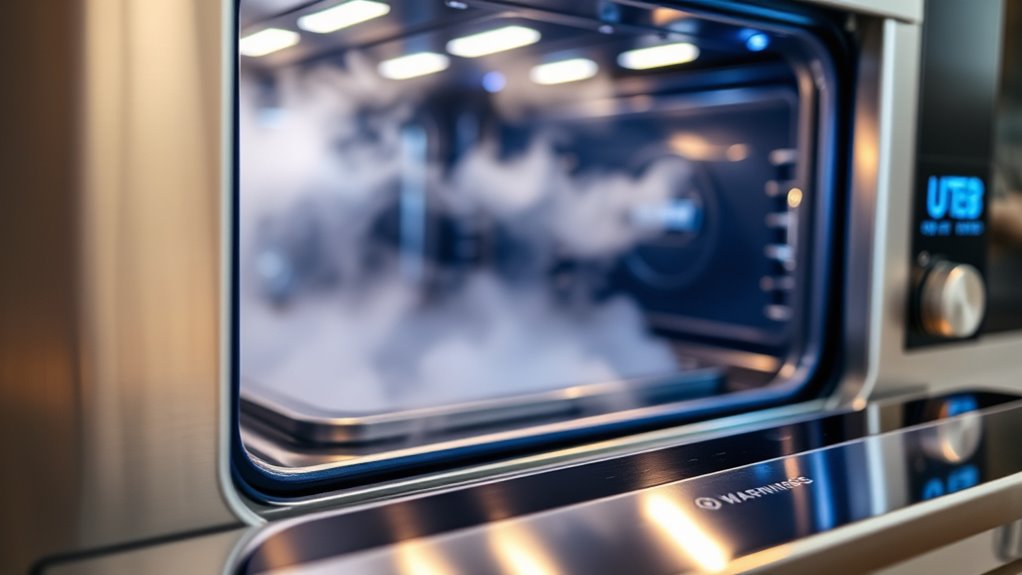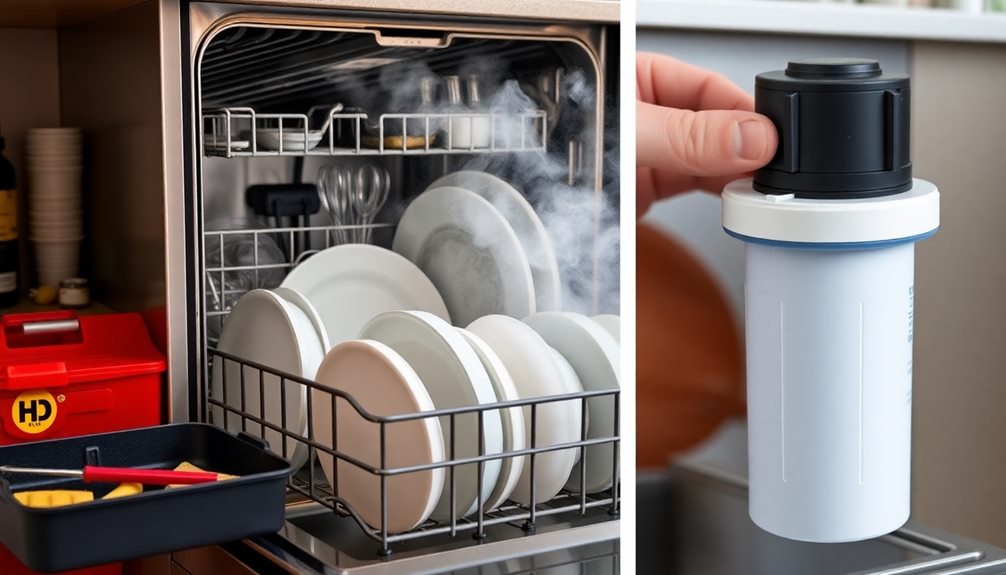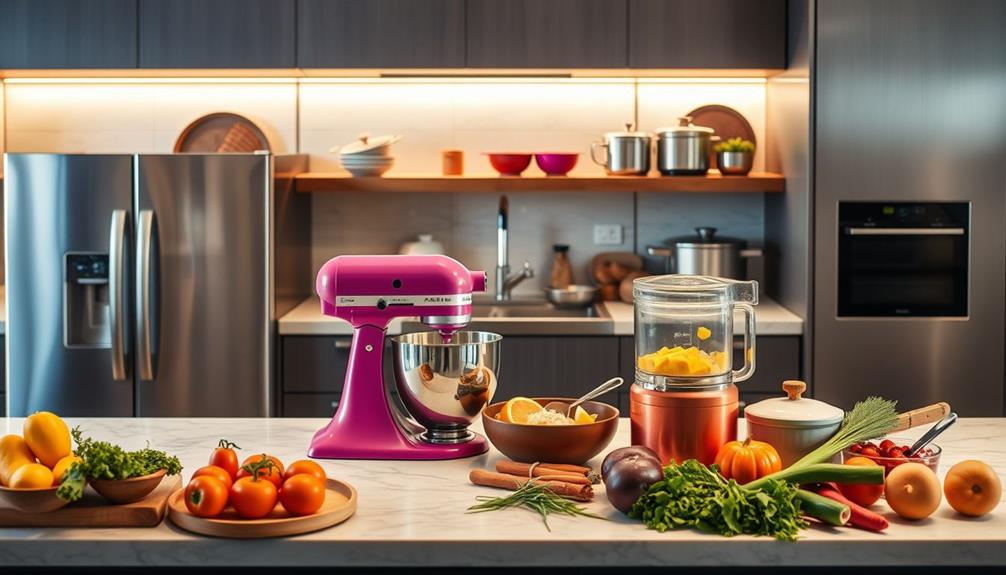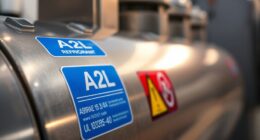Self‑cleaning ovens use different technologies to make cleanup easier. Pyrolytic cleaning heats the oven to very high temperatures, turning residue into ash you can wipe away easily. Catalytic liners absorb and break down grease during normal use, needing minimal effort. Steam cleaning uses hot steam to loosen grime quickly and eco‑friendly, but less effective on heavy stains. To choose the best tech for your needs, explore these options further and how they work in detail.
Key Takeaways
- Self-cleaning ovens use pyrolytic, catalytic, or steam methods to reduce manual cleaning efforts.
- Pyrolytic cleaning heats the oven to high temperatures to incinerate residues into ash.
- Catalytic liners absorb and break down grease during normal cooking at lower temperatures.
- Steam cleaning loosens grime with hot steam, offering an eco-friendly, quick cleaning option.
- Proper safety measures include following manufacturer instructions, ventilating, and staying nearby during cycles.
Types of Self-Cleaning Oven Technologies

There are several common types of self-cleaning oven technologies designed to make maintenance easier. The most popular is pyrolytic cleaning, which heats the oven to extremely high temperatures, turning residues into ash you can easily wipe away. Another type is catalytic cleaning, featuring special coatings on the oven walls that absorb and break down grease and food spills during cooking, reducing buildup over time. Meanwhile, some ovens combine both methods for enhanced cleaning effectiveness. These technologies are designed to reduce manual scrubbing and make oven maintenance more convenient. Each type has its own benefits and limitations, so understanding these options helps you choose the best self-cleaning system for your needs. Knowing the differences allows you to maintain your oven more efficiently and keep it in good condition.
How Pyrolytic Cleaning Works

When you activate pyrolytic cleaning, the oven heats up to extremely high temperatures, burning away food residues and grease. This high-temperature burnoff process converts organic waste into ash that can be easily wiped away. Automatic temperature control ensures the oven maintains the right heat level for effective cleaning without user intervention. Additionally, some models feature celebrity-inspired design, blending luxury aesthetics with advanced cleaning technology. The process relies on self-cleaning oven technologies to efficiently manage high heat and residue removal. Ongoing research in AI security helps ensure these systems operate safely and reliably. Furthermore, advancements in thermal management systems optimize energy use during cleaning cycles, making the process more efficient and environmentally friendly.
High-Temperature Burnoff Process
The high-temperature burnoff process, also known as pyrolytic cleaning, works by heating the oven to extremely high temperatures—typically around 900°F (500°C)—which causes food residues, grease, and other debris to break down into ash. During this process, the oven’s heating element and insulation work together to sustain the intense heat, effectively incinerating residues. Here’s how it works:
- The oven reaches the set temperature, activating the pyrolytic cycle.
- Residues are converted into ash through oxidation at high heat.
- Once the cycle ends, you simply wipe away the cooled ash with a damp cloth.
- Regular use of pyrolytic cleaning can help in reducing residue buildup, making maintenance easier over time.
This process guarantees your oven is thoroughly cleaned without harsh chemical cleaners, leaving it spotless and ready for the next use.
Organic Residue Conversion
Organic residues such as food particles, grease, and burnt-on spills undergo a chemical transformation during pyrolytic cleaning. When you activate this process, the oven heats to extremely high temperatures, typically between 800 and 900 degrees Fahrenheit. These intense conditions break down complex organic compounds into simpler molecules, mainly gases like carbon dioxide and water vapor. As the residues decompose, they turn into ash that can be easily wiped away afterward. This transformation happens silently and efficiently inside the oven, leaving no residues behind. Because the process relies on high heat rather than chemicals, it’s safe and environmentally friendly. Once the cycle completes, you’ll find the oven interior markedly cleaner, with residues reduced to a fine ash that’s simple to remove. Efficient cleaning ensures that the process is quick and effective without the need for harsh chemicals. The high temperatures involved are also similar to those used in pyrolysis, a process that breaks down organic matter through thermal decomposition. Additionally, the self-cleaning feature leverages this high-temperature pyrolytic process to maintain cleanliness with minimal effort.
Automatic Temperature Control
Automatic temperature control systems play a vital role in guaranteeing the pyrolytic cleaning process operates safely and effectively. They monitor and adjust the oven’s temperature constantly, preventing overheating and potential damage. During cleaning cycles, these systems:
- Detect temperature levels precisely, maintaining the high heat needed for ash conversion.
- Activate safety features if temperatures become unsafe, like cooling fans or lock mechanisms.
- Ensure the oven reaches and sustains the necessary temperature for the entire cycle without user intervention.
- Incorporate best airless paint sprayers to facilitate efficient and thorough cleaning after use.
- As automation technologies advance, they help ensure compliance with data privacy standards during operation, safeguarding user information and system integrity. Additionally, modern temperature control systems utilize advanced sensors to enhance accuracy and reliability in monitoring oven conditions, which is especially important for self‑cleaning oven safety protocols.
Catalytic and Aqua-Clean Systems

Catalytic and Aqua-Clean systems offer efficient ways to keep your oven spotless without extensive scrubbing. Catalytic liners are coated with special materials that break down grease and food residues as you cook, making cleanup easier over time. They work best at high temperatures and require minimal maintenance. Their ability to degrade grease and residues reduces the need for harsh cleaning methods. Additionally, the material composition of catalytic liners enhances their durability and effectiveness. The specific design features of these liners contribute to their long-lasting performance and ease of use. Aqua-Clean, on the other hand, uses steam to loosen baked-on grime. With this feature, you simply add water to a designated compartment and activate the cycle. The steam softens residues, so you can wipe them away more easily afterward. These systems are great for regular maintenance and light to moderate soils. They don’t require harsh chemicals or intense heat, making them a convenient and eco-friendly option for keeping your oven clean with less effort. Understanding the role of attention in maintaining effective cleaning routines can help optimize your oven care practices.
Advantages and Limitations of Each Method

Understanding the advantages and limitations of each self-cleaning method helps you choose what’s best for your needs. You’ll find that catalytic and pyrolytic cleaning have different strengths and weaknesses, especially when it comes to effectiveness and convenience. Let’s compare these methods to see how they stack up in real-world use. Incorporating strong communication skills when evaluating cleaning options can help you make more informed decisions that align with your household management style. For example, pyrolytic cleaning heats the oven to very high temperatures, typically around 870°F (465°C), to incinerate food residues, making it highly effective but energy-intensive.
Catalytic vs. Pyrolytic Cleaning
When it comes to cleaning your oven, choosing between catalytic and pyrolytic methods depends on your cleaning preferences and needs. Catalytic cleaners use special liners that absorb and break down grease at lower temperatures, making routine cleaning easier. Pyrolytic cleaning, on the other hand, heats the oven to extremely high temperatures to incinerate food residues completely.
Here’s a quick comparison:
- Ease of Use: Catalytic liners require regular wiping, while pyrolytic cleaning is a once-in-a-while deep clean.
- Effectiveness: Pyrolytic cleans more thoroughly, removing stubborn residues, but catalytic liners handle light grease well.
- Limitations: Catalytic liners can’t handle heavy spills, and pyrolytic cycles consume more energy and require door locking.
Steam Cleaning Effectiveness
Steam cleaning offers a convenient and eco-friendly way to maintain your oven without harsh chemicals or intense scrubbing. It uses hot steam to loosen grease and grime, making cleanup easier. While effective for light to moderate messes, it might struggle with heavily baked-on residues. The process is quick, typically taking less than an hour, and leaves no chemical residues behind. Here’s a quick comparison:
| Advantage | Limitation |
|---|---|
| Eco-friendly, chemical-free | Less effective on heavy stains |
| Quick and easy to use | Limited deep cleaning power |
| Gentle on oven surfaces | May require multiple sessions |
| No fumes or odors | Not suitable for very dirty ovens |
Self-Cleaning Limitations
While steam cleaning offers a gentle and eco-friendly option for maintaining your oven, it does have notable limitations. First, it may not remove stubborn, baked-on grease or heavy residue effectively. Second, steam cleaning often requires multiple cycles to achieve desired cleanliness, which can be time-consuming. Third, it’s less effective on caked-on food or thick grime, meaning you might still need to scrub manually afterward. Additionally, steam cleaning isn’t suitable for all oven types, especially those with electronic components that could be damaged by moisture. Overall, while convenient for light cleaning, steam methods fall short when dealing with tougher messes or deep grime buildup. You’ll need to contemplate alternative cleaning methods for more thorough results.
Maintenance Tips for Self-Cleaning Ovens

Regularly maintaining your self-cleaning oven guarantees it performs efficiently and extends its lifespan. Start by wiping down the interior after each use to remove food splatters and spills. Use a damp cloth and mild detergent, avoiding harsh chemicals that could damage the surface. Check and clean the oven’s vents and filters periodically to ensure proper airflow during cleaning cycles. Remove racks and clean them separately with warm, soapy water to prevent buildup. Avoid using abrasive scrubbers that can scratch surfaces. Keep the oven door seal clean and intact to maintain a proper seal during cleaning cycles. Regular inspections help identify any issues early, preventing costly repairs. Following these simple tips keeps your oven in good shape and ready for its self-cleaning functions whenever needed.
Safety Considerations During Cleaning Cycles

Ensuring safety during the self-cleaning cycle is essential to prevent accidents and damage. You should always follow the manufacturer’s instructions carefully and stay nearby during cleaning. Here are some key safety tips:
- Keep the area well-ventilated to avoid inhaling fumes released during cleaning.
- Remove any oven racks, utensils, or foil that could warp or melt.
- Avoid opening the oven door during the cycle, as extremely high temperatures can cause burns or damage the oven.
Choosing the Right Self-Cleaning Oven for Your Kitchen

Are you unsure how to select a self-cleaning oven that fits your kitchen needs? Start by considering your space and cooking habits. Measure your available area to ensure the oven fits comfortably. Think about the cleaning cycle features—do you prefer a pyrolytic system that reaches high temperatures or a steam clean option? Look for user-friendly controls and clear instructions to make maintenance easy. Energy efficiency is also key; choose an oven with good energy ratings to save on electricity. Consider the oven’s size and capacity based on your typical meal prep. Finally, read reviews to gauge reliability and customer satisfaction. Picking the right model means balancing features, size, and budget to find an oven that complements your lifestyle and kitchen layout.
Frequently Asked Questions
How Long Does a Typical Self-Cleaning Cycle Last?
A typical self-cleaning cycle lasts between two to four hours, depending on the oven model and chosen settings. During this time, the oven heats to extremely high temperatures to burn off food residues. You should stay nearby and guarantee proper ventilation, as strong odors and smoke might occur. Once the cycle completes, allow the oven to cool before wiping away ash or debris for a clean, fresh interior.
Can I Use Oven Cleaners During or After Self-Cleaning?
You shouldn’t use oven cleaners during or after a self-cleaning cycle. The high heat from the cycle burns off residues, making chemical cleaners unnecessary and potentially harmful. After the cycle ends, wait until the oven cools completely before cleaning manually with a damp cloth. Using chemical cleaners during this time can cause dangerous fumes or damage your oven’s interior. Always follow your manufacturer’s instructions for safe cleaning.
Are Self-Cleaning Ovens Energy-Efficient Compared to Manual Cleaning?
You might think self-cleaning ovens use lots of energy, but they’re actually more efficient than manual cleaning. While manual scrubbing takes time and water, self-clean cycles heat the oven to high temperatures quickly, reducing energy use overall. Plus, they save you effort and water, making them a smarter, more eco-friendly choice. So, if energy efficiency matters, a self-cleaning oven is a better option than manual cleaning.
What Are Common Signs That a Self-Cleaning Oven Needs Repair?
If your self-cleaning oven needs repair, you’ll notice some clear signs. It might not heat up properly or fail to start the cleaning cycle. You could hear unusual noises or see the door won’t lock during cleaning. Sometimes, it won’t respond to controls or displays error messages. These issues indicate mechanical or electrical problems that require professional repair to keep your oven safe and functioning efficiently.
How Often Should I Run the Self-Cleaning Cycle?
Think of your oven as a trusted friend who needs regular care. You should run the self-cleaning cycle every three to six months, depending on usage. If you cook heavily or often, consider cleaning more frequently. Regular cleaning keeps the oven’s heart healthy and functioning smoothly, preventing buildup that can cause problems. By maintaining this routine, you guarantee your oven remains reliable and ready for the next culinary challenge.
Conclusion
Understanding the different self-cleaning oven technologies helps you choose what’s best for your kitchen. Think of each method as a trusted companion, each with its strengths and quirks. By knowing how they work and their limitations, you can keep your oven spotless without surprises. When you select the right system and follow safety tips, you’re not just cleaning—you’re nurturing a well-loved tool that serves you like a loyal friend through many meals ahead.










